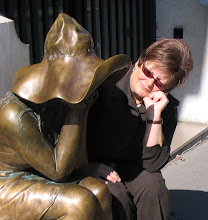Plaque reads:
May 1942 Tule Lake March 1946
Tule Lake was one of ten American concentration camps established during World War II to incarcerate 110,000 persons of Japanese ancestry, of whom the majority were American citizens, behind barbed wire and guard towers without charge, trial, or establishment of guilt. These camps are reminders of how racism, economic and political exploitation, and expediency can undermine the constitutional guarantees of United States citizens and aliens alike. May the injustices and humiliation suffered here never recur
California registered historical landmark No. 850-2 Plaque placed by the State Department of Parks and Recreation in cooperation with the Northern California-Western Nevada District Council, Japanese-American Citizens League, May 27, 1979
During my college days I had a gifted friend who was Japanese-American. He taught me about the shame brought on US citizens of Japanese ancestry during WWII. A government proclamation ordered them “for their own safety” to be sent to relocation camps in out-of-the-way, generally uninhabited, places. Ten such camps were created in the US eventually housing 120,000 people (sources vary). Tulelake was one of these internment camps, as they came to be called.
Two books I have since read on the subject of the Nisei, these Americans of Japanese descent, have increased my awareness and impacted me. They are Snow Falling on Cedars by David Guterson, and Silent Honor by Danielle Steel. A more recent movie, “Come See the Paradise” (with Dennis Quaid), gave a vivid and unsettling portrayal of the camps. Later, my friendship with a school secretary who was married to a Japanese man born just after his parents’ internment gave further insight into the racial discrimination they suffered while being loyal citizens of the US. They lost their family business, a florist shop, gave up treasured household items to neighbors, and suffered many indignities. Her husband was born in a hospital hallway because they would not give his Japanese mother a room.
However, this subject is still controversial. From accusations of racial profiling to defensive protestations of protecting America’s west coast from possible attack by the Japanese after its Pearl Harbor attack, from deep shame at turning against our own citizens (declared unconstitutional on Dec. 17, 1944 by the US Supreme Court) to defense of the internment as a necessity of wartime due to continuing loyalties between the US Japanese and their homeland and relatives with whom we were at war: there is still a debate concerning whether or not the interment was justifiable. Particularly the West Coast military installations and factories were considered vulnerable. But there is a deep shame about it, too, when the scab is uncovered, much like the issue of slavery can be spoken about in terms of both economic necessity and wrongful treatment of human beings.
Michelle Malkin has written In Defense of Internment: The Case for Racial Profiling in WWII and the War on Terror (2004). I have not read it but I plan to. In Malkin’s book, internment was the result of national security concerns and not just racism or wartime hysteria, says the publisher.



Children of the Camps http://www.pbs.org/childofcamp/documentary/index.html
A Challenge to Democracy :
http://www.archive.org/details/Challeng1944
These propaganda films showed life in the camps in a positive light, the Japanese happy and content. Although most of the locations of the relocation/internment camps were in desert lands never before farmed or previously occupied, the films indicated that the ‘industrious’ Japanese (many of whom had never farmed) were happy to clear the land, dig irrigation ditches, and cultivate crops. They were given a 20x25 foot single room per family in a barracks that housed several hundred. The ‘resourceful among them’ could build partitions to make rooms and compartments for bedrooms, and using their ‘ingenuity’ women could make curtains for their windows (here a happy Japanese homemaker is shown hanging her new curtains.) The food in the cafeteria was “nourishing but simple”. The schoolrooms were manned by Caucasian and evacuee teachers who “trained the internees for better jobs outside”. Elections were held “in a democratic manner.” There were hundreds of baseball teams, and parades with floats, and Boy Scouts, and beauty queens. Admittedly home life was disrupted, and the training of children abnormal, but the Japanese “responded cheerfully, happy to help the American war cause.” Their businesses were leased to others, their fishing fleets impounded, orchards lost, doctors and dentists lost their practices, but the young Japanese men who enlisted in the war effort saw themselves as “soldiers fighting for democracy and freedom of opportunity, regardless of race or creed or national origin.”
“The Tule Lake Unit is a reminder to all Americans that the Constitution is no more than a piece of paper unless we are willing to defend its principles.” quote from plaque, above




3 comments:
I must tell you that Tulelake is spelled as one word on their newspaper and streetsigns and as two words in some applications. So the above story seems inconsistent, but isn't really.
So thought provoking. Fear really takes a toll on clear thinking. During the cold war my sister and I were interogated at work because they feared we might be young communists trying to work our way into corporations, or some other kind of nonsense.
Interesting post...and hard to believe! But the same thing happened in Canada as well...with 22,000 Japanese Canadians being sent to internment camps.
Post a Comment